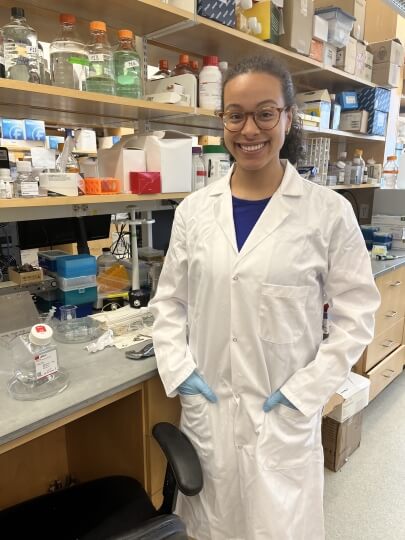For a senior capstone project, Sydney Kepler used tissue-engineered blood vessels to study the relationship between the outermost arterial vessel layer, arterial fibrosis and cardiovascular disease.
Engineering Design Projects (ES 100), the capstone course at the Harvard John A. Paulson School of Engineering and Applied Sciences (SEAS), challenges seniors to engineer a creative solution to a real-world problem.
Engineering a Biomimetic Adventitia to Model Fibrosis in a Tissue-Engineered Blood Vessel
Sydney Kepler, S.B. ‘23, Bioengineering
Advisor: Richard Cheng
Please give a brief summary of your project.
Cardiovascular disease (CVD) is the global leading cause of death. CVD is commonly caused by fibrosis, or the stiffening of arterial vessel walls. Due to the simplicity and lack of tunability of existing fibrosis models, it remains difficult to understand the significance of the outermost vessel layer, the tunica adventitia, in fibrosis development. The goals of this project are to use a tri-layered tissue-engineered blood vessel (TEBV) to study arterial fibrosis in vitro and screen anti-fibrotic drug candidates.
How did you come up with this idea for your final project?
I spent the past summer in the Harvard Program for Research in Science and Engineering, and my project was focused on assessing smooth muscle cell maturation in two-dimensional vs. three-dimensional environments. At the start of my senior year, my research advisor and I were brainstorming what we could add to our current tissue-engineered blood vessel model to continue our research, and we landed on adding the last main component our model is missing: the tunica adventitia.
Is there a real-world challenge that this project addresses?
This project works to develop a vascular model to understand the role of the adventitia in the development of vascular diseases such as arterial fibrosis, and ultimately cardiovascular disease. This project works to build on the complexity of existing in vitro models to more accurately model vascular disease. This TEBV model is working to be used for patient engraftment in hopes of providing an alternative to blood vessel treatments.
What was the timeline of your project?
I spent most of September-November defining the scope of my project, learning blood vessel fabrication techniques, and choosing exactly how I wanted to design this blood vessel layer. In December, I began to build blood vessels containing the adventitia, and I took my first multi-photon image of the layered vessel right before winter break. I spent the start of this spring semester perfecting the technique to build the vessels, and the majority of this semester was dedicated to characterizing the addition of this new layer onto the blood vessel and how it affected the other blood vessel layers.
What part of the project proved the most challenging?
I think the build component of this project was the most difficult. Each step of fabricating these tissue-engineered blood vessels is so technical, it sort of feels like an art. The process is not only technically difficult but there is also a high risk of contamination. There is a balance between being quick, sterile, and precise, and it required a certain level of finesse that took a substantial amount of time to learn. The timeline of creating a single blood vessel takes several days, and if contamination occurs (which it did half of the time), we had to restart from the beginning. As a result, creating the many different blood vessels needed for experimentation required a substantial amount of patience.
What did you learn, or skills did you gain, through this project?
I learned how to make blood vessels. I learned how to image using multi-photon microscopy. I learned how to prep samples to run RT-PCR, and how to analyze amplification curves. I learned how to prep samples for FACS and how to effectively sort cell populations. I learned how to manage my time to complete monumental tasks. I learned how to become a better scientific communicator with my advisors and mentors in my lab. I learned the importance of organization and careful experimental planning far before experiments are carried out. I learned how to be flexible with the scope of my project and how to be realistic with what I can accomplish during the span of eight months.
What part of the project did you enjoy the most?
I really enjoyed seeing the skills that I have learned over the past two years (many of which have been learned in the past six months) generate tangible and promising data. It’s really cool to see the results I got and the figures I made, take a step back, and reflect on the hours I spent fabricating the blood vessels, learning new techniques to acquire the data, and analyzing the data. It makes me really proud of how far I’ve come over the past two years as a researcher and engineer.
Press Contact
Matt Goisman | mgoisman@g.harvard.edu
